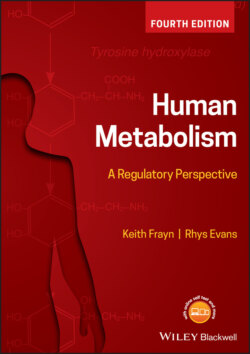Читать книгу Human Metabolism - Keith N. Frayn - Страница 36
1.3.2.1.3 Lactate and ethanol metabolism
ОглавлениеThe reduction of glycolysis-derived pyruvate to lactate by the near-equilibrium (freely reversible) enzyme lactate dehydrogenase is an important mechanism to permit glycolysis to proceed. Glycolysis involves one redox step that is linked to NADH formation from NAD+. Normally, when oxygen is present in the cell, the NADH is reoxidised back to NAD+ by the electron transport chain within the mitochondria: this is vital because the NAD+ is required for further electron capture to permit glycolysis to proceed. In the absence of oxygen however, (or, indeed, in the absence of mitochondria, as in red blood cells), NADH would accumulate and NAD+ concentration would fall too low. By converting pyruvate to lactate and linking this to NAD, the NAD+ is regenerated to permit glycolysis to proceed, but at the cost of accumulating lactate (Figure 1.15a). When oxygen becomes available, lactate dehydrogenase can readily convert the lactate back to pyruvate (and NADH) for oxidation (and red blood cells export the lactate to the liver to be converted back into pyruvate).
Figure 1.15 Lactate and ethanol metabolism. Glycolysis produces NADH from NAD+. (a) In aerobic conditions in mammals the NAD+ is regenerated by the electron transport chain, but in anaerobic conditions NAD+ must be regenerated by lactate dehydrogenase, permitting glycolysis to continue, at the cost of accumulating lactate. (b) In yeast, pyruvate is instead reduced to ethanol in order to regenerate NAD+ and allow glycolysis to proceed (brown arrows). When humans ingest alcohol, the ethanol is oxidised to acetyl-CoA via acetaldehyde, providing a large influx of energy but also altering the NAD+:NADH ratio.
Yeast employ a different strategy to oxidise NADH and regenerate NAD+. Instead of reducing pyruvate to lactate, they reduce pyruvate to ethanol (CH3·CH2·OH) by the process of alcoholic fermentation, shown in Figure 1.15b. Pyruvate is first decarboxylated to acetaldehyde (CH3·CHO) and carbon dioxide is produced (anyone who has made their own wine by using yeast to ferment the sugar in grape juice will be familiar with the bubbles of CO2 gas given off during the fermentation). The acetaldehyde is then reduced to ethanol by alcohol dehydrogenase, reoxidising the NADH back to NAD+ so that glycolysis can proceed. This process has the advantage for yeasts that the ethanol is toxic to many organisms, but yeast can tolerate ethanol in high concentrations, hence their ‘waste product’ inhibits other, competing micro-organisms. When humans ingest ethanol, it is converted back into acetaldehyde by our alcohol dehydrogenase (and the acetaldehyde is probably at least partly responsible for the ‘hangover’ effects of excessive alcohol consumption), and then on to acetate and ultimately acetyl-CoA (Figure 1.15b). Acetyl-CoA can go on to be oxidised by the TCA cycle or used for lipid synthesis (see Section 1.3.3), in other words ethanol provides a large amount of ingested energy. But in addition, metabolism of ethanol reduces large amounts of NAD+ to NADH, providing more energy again, but also disrupting the NAD+:NADH ratio; this has the effect of inhibiting gluconeogenesis (Section 1.3.2.1.5) and causing the hypoglycaemia that is probably the origin of the stimulated appetite commonly seen following alcohol consumption.
